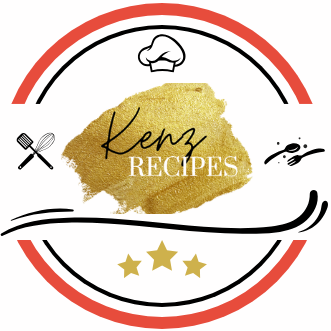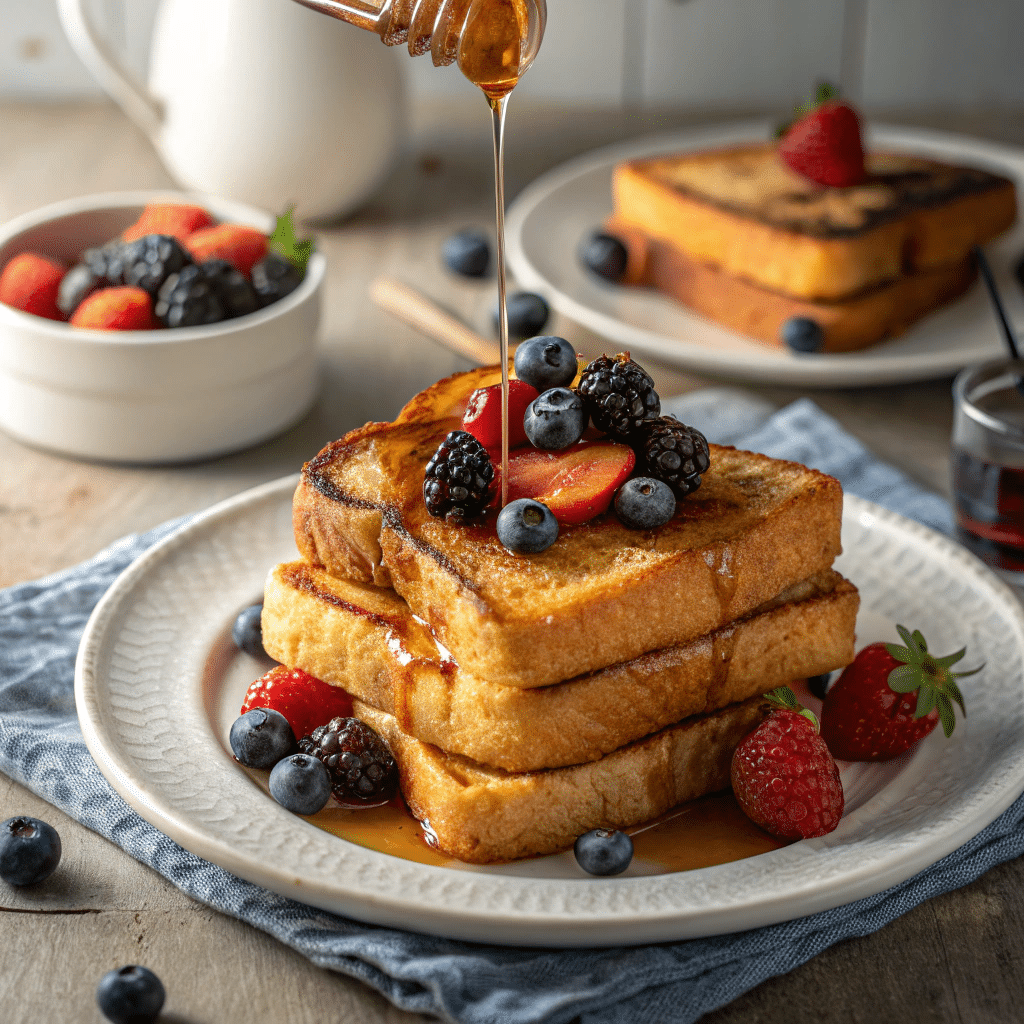Craving something warm, comforting, and indulgent for breakfast? French toast is a classic that never goes out of style. Whether you’re making brunch for your family or treating yourself on a slow weekend morning, this golden, custard-soaked bread dish hits the spot every time. In this article, we’ll show you how to make French toast the right way—from choosing the best bread to mastering the custard mixture and getting that perfect golden-brown crust. This guide is made especially for Kenz Recipes fans who value taste, simplicity, and a touch of creativity in their kitchen.
Table of Contents
Print Recipe
Classic French Toast
Equipment
- Mixing bowl
- Whisk
- Large skillet or griddle
- Spatula
Ingredients
For the French Toast
- 4 slices thick bread Brioche, challah, or French bread work best.
- 2 large eggs
- ½ cup whole milk Or use half-and-half for extra richness.
- 1 tbsp sugar Optional, for added sweetness.
- 1 tsp vanilla extract For flavor.
- ½ tsp ground cinnamon For warmth and spice.
- pinch salt Balances the sweetness.
- 1 tbsp butter For frying.
Instructions
- In a mixing bowl, whisk together eggs, milk, sugar (if using), vanilla extract, cinnamon, and a pinch of salt until smooth.
- Heat a large skillet or griddle over medium heat and melt the butter.
- Dip each slice of bread into the egg mixture, coating both sides evenly, but not soaking too long to prevent sogginess.
- Place the soaked bread slices onto the heated skillet and cook for 2–3 minutes per side, or until golden brown and crispy.
- Remove from heat and serve warm with maple syrup, fresh berries, or powdered sugar.
Notes
What Is French Toast?
A Brief History of French Toast
French toast, also known as “pain perdu” (meaning “lost bread” in French), dates back to ancient Rome. The dish was originally created as a way to use stale bread, soaking it in a milk and egg mixture before frying it to bring it back to life. Over time, French toast became a popular breakfast dish worldwide, with different variations in every culture.
French Toast History & Origins: https://www.britannica.com/
Why Is So Popular
- Simple Ingredients – Uses pantry staples like bread, eggs, milk, and sugar.
- Quick & Easy – Ready in under 15 minutes.
- Customizable – Can be made sweet or savory, with endless toppings and flavors.
- Perfect for Stale Bread – A great way to use up day-old or slightly dry bread.
Ingredients for the Best Classic French Toast
To make the best golden, fluffy, and flavorful French toast, you need just a few simple ingredients.
Basic Ingredients:
- 4 slices of thick bread (brioche, challah, or French bread work best)
- 2 large eggs
- ½ cup whole milk (or half-and-half for extra richness)
- 1 tablespoon sugar (optional, for added sweetness)
- 1 teaspoon vanilla extract
- ½ teaspoon ground cinnamon
- Pinch of salt (balances the sweetness)
- 1 tablespoon butter (for frying)
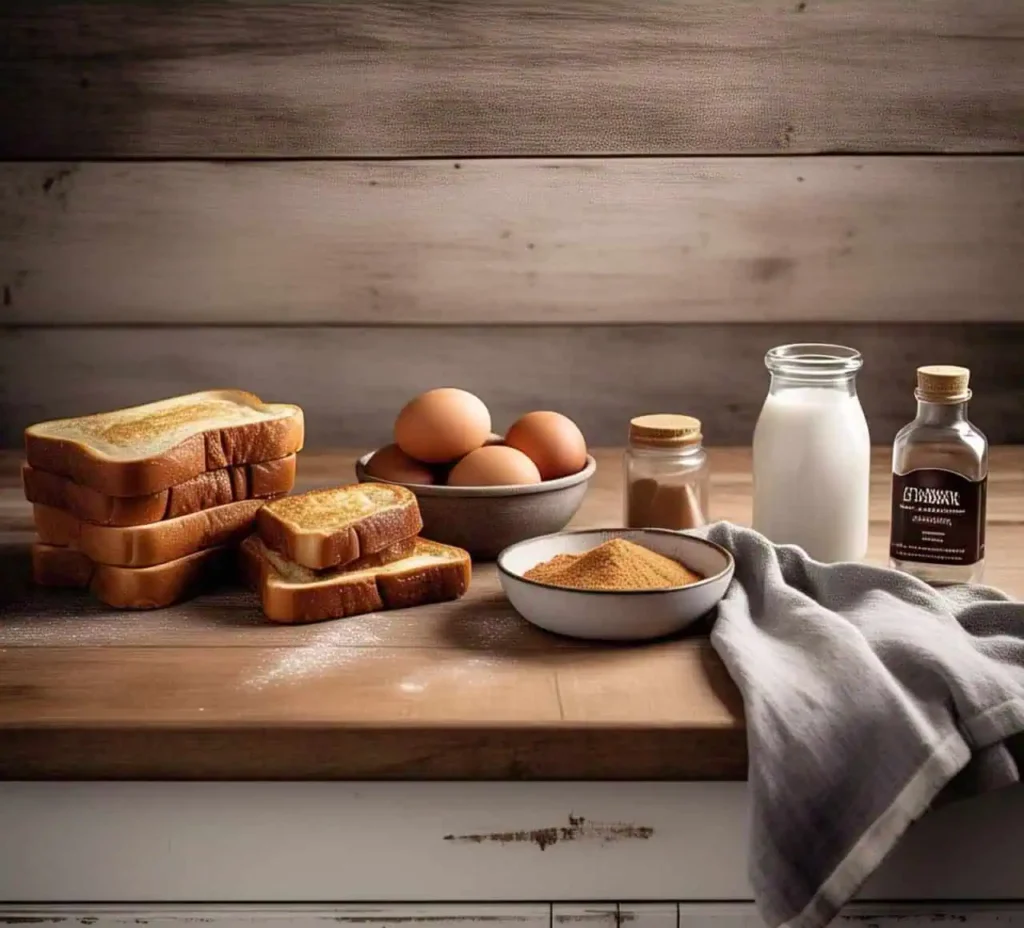
Optional Add-Ins:
- Heavy cream – For a richer custard texture.
- Nutmeg – Adds warmth and depth to the flavor.
- Maple syrup or honey – Can be added to the egg mixture for extra sweetness.
Step-by-Step Instructions
Follow these easy steps to make perfectly golden, crispy, and fluffy Toast every time.
Step 1: Prepare the Egg Mixture
1. In a shallow bowl or baking dish, whisk together:
- 2 large eggs
- ½ cup whole milk (or half-and-half for richness)
- 1 tablespoon sugar (optional)
- 1 teaspoon vanilla extract
- ½ teaspoon cinnamon
- A pinch of salt
2. Mix well until the ingredients are fully combined and slightly frothy.
Step 2: Prepare the Bread
- Choose thick-sliced bread (like brioche, challah, or French bread).
- If the bread is too fresh, let it sit out for 10–15 minutes to slightly dry out. This helps prevent soggy French toast.
Step 3: Dip the Bread into the Mixture
- Place one slice of bread at a time into the egg mixture.
- Let it soak for 10–15 seconds per side (longer for denser bread like sourdough).
- Flip and coat the other side evenly.
- Lift the bread and let any excess mixture drip off before transferring to the pan.
Step 4: Cook the French Toast
- Heat a large skillet or griddle over medium heat.
- Melt 1 tablespoon of butter in the pan.
- Place the soaked bread slices in the pan, making sure they aren’t overcrowded.
- Cook for 2–3 minutes per side, or until golden brown and slightly crispy.
- Flip and cook the other side until golden and fully set.
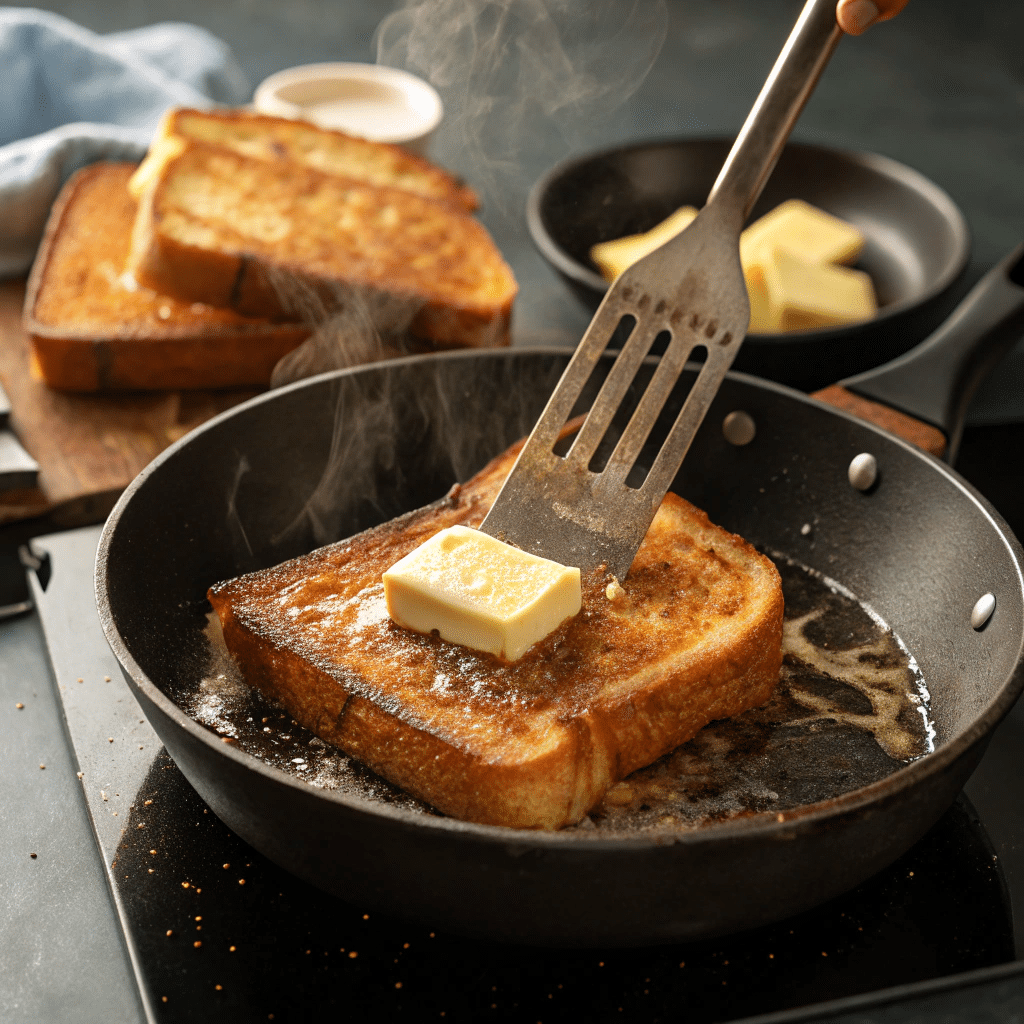
Step 5: Serve Immediately
- Transfer to a plate and serve warm.
- Top with powdered sugar, maple syrup, fresh fruit, or whipped cream.
- Enjoy with a side of bacon, sausage, or fresh juice for a complete breakfast.
Tips for Making Perfect French Toast
Making French toast is simple, but a few key techniques can take it from good to amazing. Follow these expert tips for golden, crispy, and flavorful results every time.
Choose the Right Bread
- Thick-cut bread works best (brioche, challah, or French bread).
- Slightly stale or day-old bread absorbs the egg mixture better and prevents sogginess.
- If using fresh bread, let it sit out for 10–15 minutes to dry slightly before soaking.
Use the Right Egg-to-Milk Ratio
- Too much milk can make the toast too wet, while too many eggs can make it too firm.
- A good ratio is 2 eggs per ½ cup of milk for a custardy texture.
Whisk the Egg Mixture Thoroughly
- Beat the eggs, milk, vanilla, and cinnamon until smooth and frothy.
- This ensures an even soak and prevents streaks of egg whites on the bread.
Don’t Over soak the Bread
- Thin bread = quick soak (5–10 seconds per side).
- Thicker bread = slightly longer soak (10–15 seconds per side).
- Over-soaking leads to soggy French toast that doesn’t crisp up properly.
Cook at the Right Temperature
- Medium heat is best for a crispy exterior and fully cooked interior.
- Cooking on high heat can burn the outside while leaving the inside raw.
Use Butter for the Best Flavor
- Butter gives French toast richness and a golden crust.
- If cooking multiple batches, wipe the pan and add fresh butter to prevent burning.
Delicious Variations of French Toast
French toast is incredibly versatile, and you can customize it in many delicious ways. Try these variations to elevate your breakfast experience.
Classic Cinnamon Toast
- Add ½ teaspoon extra cinnamon to the egg mixture.
- Sprinkle with cinnamon sugar after cooking for extra flavor.
Stuffed Toast
- Spread cream cheese, Nutella, peanut butter, or jam between two slices of bread before dipping in the egg mixture.
- Cook as usual for a rich, dessert-like treat.
Brioche or Challah Toast
- Use brioche or challah for an extra soft, buttery texture.
- Pairs well with powdered sugar and berries.
Savory French Toast
- Omit sugar and vanilla; add salt, pepper, and herbs.
- Serve with cheese, bacon, smoked salmon, or avocado.
French Toast Casserole
- Cube day-old bread, layer it in a baking dish, and pour the egg mixture over it.
- Bake at 350°F for 30–40 minutes for an easy make-ahead breakfast.
Dairy-Free French Toast
- Replace milk with almond, oat, or coconut milk.
- Use vegan butter for frying.
Keto-Friendly Toast
- Use low-carb bread or almond flour bread.
- Replace sugar with a sugar-free sweetener.
French Toast Sticks (Kid-Friendly Version)
- Cut bread into thick strips before dipping and frying.
- Serve with maple syrup or chocolate sauce for dipping.
These variations let you experiment with flavors and textures while keeping the classic French toast experience.
Best Toppings for Classic Toast
The right toppings can take French toast from simple to spectacular. Here are some of the best ways to serve it.
Classic Sweet Toppings
- Maple syrup – The ultimate classic, adding sweetness and moisture.
- Powdered sugar – A light dusting enhances the flavor.
- Honey or agave syrup – A natural alternative to syrup.
Fresh Fruits
- Strawberries, blueberries, raspberries, or blackberries – Adds a fresh, tart contrast.
- Sliced bananas – Pairs well with peanut butter or Nutella.
- Caramelized apples or peaches – Cooked in butter and cinnamon for extra flavor.
Whipped Cream and Spreads
- Homemade whipped cream – Light and fluffy for a decadent touch.
- Nutella or peanut butter – A rich and creamy topping.
- Cream cheese glaze – A tangy, sweet drizzle.
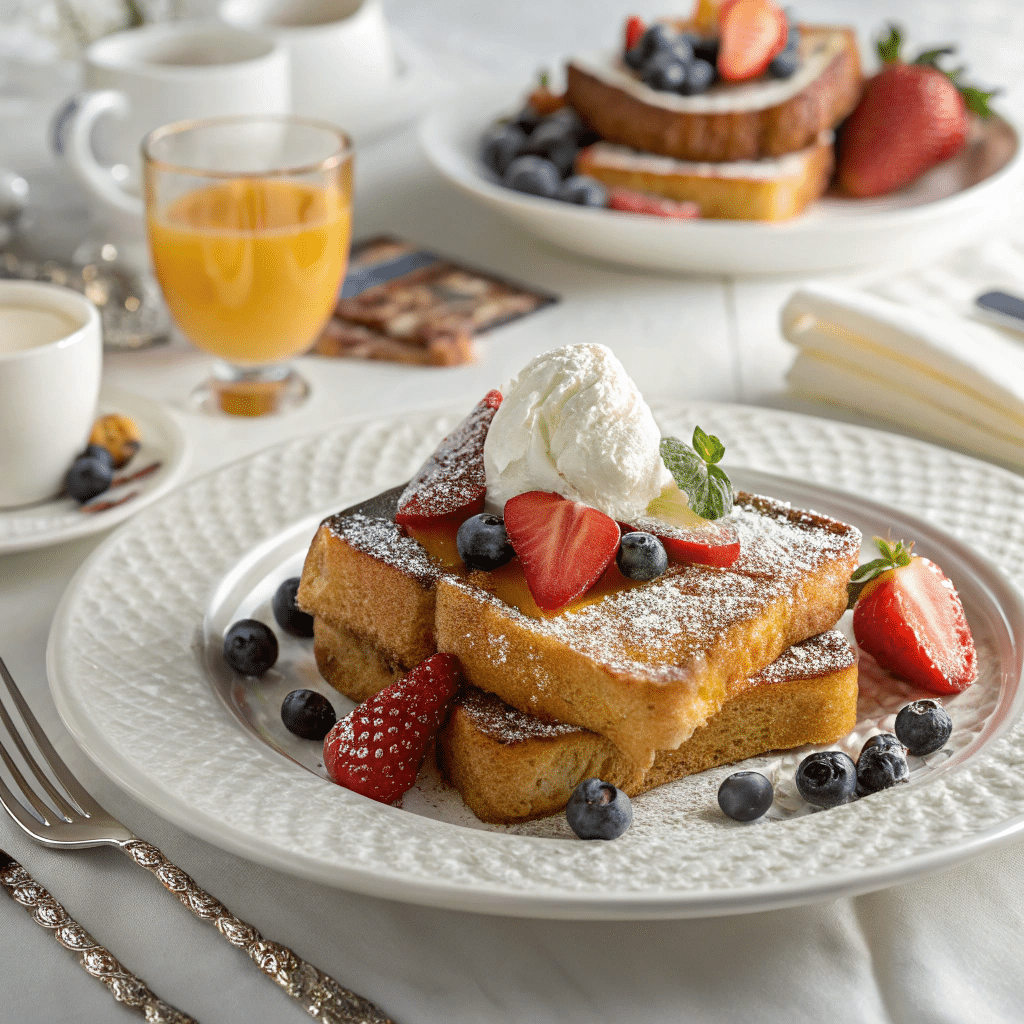
Crunchy Add-Ons
- Chopped nuts (almonds, pecans, walnuts) – Adds texture and flavor.
- Granola – A crunchy, healthy topping option.
- Coconut flakes – Lightly toasted for a tropical twist.
Chocolate and Caramel Drizzles
- Melted dark or milk chocolate – A dessert-like treat.
- Salted caramel sauce – For a sweet and salty balance.
Savory Toppings (For a Unique Twist)
- Fried eggs and bacon – Combines sweet and savory flavors.
- Goat cheese and honey – A tangy-sweet combination.
- Avocado and smoked salmon – A gourmet, savory version.
With so many topping options, you can make French toast different every time!
Make-Ahead and Storage Tips
Prepping French Toast in Advance
French toast can be made ahead and kept in the fridge for up to 3 days. Reheat in a toaster oven or air fryer for crispiness.
Freezing and Reheating Tips
Freeze slices between parchment paper, then reheat directly in the oven at 375°F for 8-10 minutes. Great for busy mornings.
Health Benefits and Nutritional Facts
French toast can be a nutritious and satisfying breakfast when made with the right ingredients. Below is a breakdown of its nutritional value and tips to make it healthier.
Nutritional Breakdown (Per Serving, Based on 2 Slices with Basic Ingredients)
- Calories: 250–350 kcal
- Carbohydrates: 35–40g
- Protein: 10–12g
- Fat: 8–12g
- Sugar: 5–10g (varies based on sweeteners and toppings)
- Fiber: 2–4g (higher with whole wheat bread)
Health Benefits of French Toast
Good Source of Protein
- Eggs provide high-quality protein, essential for muscle repair and energy.
Contains Essential Vitamins and Minerals
- Milk and eggs contain calcium, vitamin D, and B vitamins.
- Whole wheat or enriched bread provides iron and fiber.

Can Be Made Healthier
French toast can be a balanced breakfast when prepared with healthier choices:
- Use whole grain bread for more fiber and nutrients.
- Opt for unsweetened milk (almond, oat, or dairy) to reduce added sugar.
- Replace sugar with natural sweeteners like honey or mashed bananas.
- Cook with coconut oil or ghee instead of butter for a healthier fat alternative.
USDA Nutrition Database for Bread and Eggs: https://fdc.nal.usda.gov/
Frequently Asked Questions (FAQs)
Can I Use Stale Bread for French Toast?
Yes! Slightly stale bread works best because it absorbs the egg mixture without getting too soggy. If your bread is fresh, let it sit out for 10–15 minutes before using.
Can I Make French Toast Ahead of Time?
Yes! You can:
Refrigerate cooked French toast for up to 3 days.
Freeze slices for up to 2 months (separate them with parchment paper).
Reheat in the oven or toaster for a crispy texture.
Can I Make French Toast Without Milk?
Yes! You can substitute milk with:
Almond, oat, coconut, or soy milk for a dairy-free option.
Orange juice for a citrusy flavor.
Why Is My French Toast Soggy?
This usually happens when:
The bread is too thin or fresh.
The egg mixture has too much liquid (adjust the milk-to-egg ratio).
The bread is soaked for too long (stick to 10–15 seconds per side).
Can I Make Toast Without Eggs?
Yes! Replace eggs with:
Mashed bananas (¼ cup per egg).
Flaxseed egg (1 tablespoon ground flaxseed + 3 tablespoons water per egg).
Greek yogurt (¼ cup per egg).
What’s the Best Bread for French Toast?
The best bread options include:
Brioche – Soft, buttery, and slightly sweet.
Challah – Rich, eggy texture that soaks well.
French bread – Slightly chewy with a crispy crust.
Sourdough – Adds a tangy flavor and firmer texture.
Conclusion
French toast is a timeless, delicious, and versatile breakfast dish that’s easy to make with just a few simple ingredients. Whether you prefer it classic, stuffed, or with unique toppings, this recipe can be customized to suit any taste.
By using the right bread, perfecting the egg mixture, and cooking at the right temperature, you can achieve golden, crispy, and flavorful French toast every time. Plus, with options like whole wheat, dairy-free, or low-carb variations, you can make it as indulgent or healthy as you like.
Serve it fresh with your favorite toppings, or store and reheat it for a quick meal prep option. No matter how you enjoy it, French toast is always a breakfast favorite that brings warmth and comfort to the table.
Did you try this classic French toast recipe? Share your favorite toppings in the comments! Don’t forget to save this recipe for later.
For more Recipes to Try
Check out these recipes:
- Citrus Mandarin Orange Cake Recipe: Discover vibrant orange dessert that pairs citrus flavors with a moist and tender cake base.
- Chocolate Orange Cake Recipe: Explore a richer take on orange desserts by combining chocolate and orange for a sophisticated treat.
